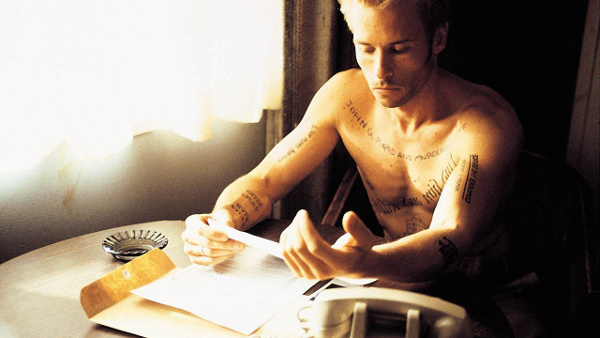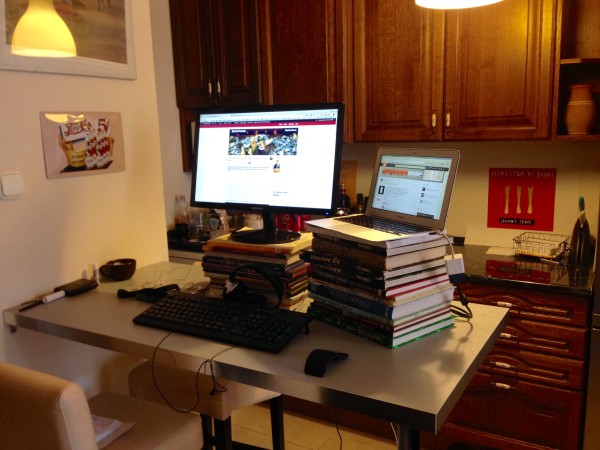7 Key Lessons From Business Building in 2015

Or, what happened to SpartanTraveler last year.
Editor’s Note: Many thanks to all those who encouraged me to get back to writing. 2015 was a bit of a grind, but the good news is I’ve got plenty to share from the experience.
Fear not, trusty readers, SpartanTraveler is alive and well.
But getting somewhere in life is about making hard choices, and the reality in 2015 was simple: focus or die.
Because when you do everything you do nothing.
‘Like the sculptor, who does not add clay, but strips away the inessentials until the truth is revealed.’
– Bruce Lee character from Dragon
I’ve always thrived at the breaking point of manageable activity. That place where positive stress forces focus and serious action. Where the goals and the necessity for completing them are immediately clear.
As a result, I always assumed as life went I’d continue to be doing more. More traveling, more and different types of adventures, and more varieties of work.
But bigger goals require more focus and refinement, which means you can do fewer big things and expect to get anywhere. Laser-focus can move mountains, but spread that focus out and you end up wondering how a year went by with nothing to show for it.
Every year the key things I’m willing to spend effort on get fewer, not greater. It’s actually amazing how little I can effectively do at once.
The rule of keeping it simple is even clearer in business: every variable in the system adds a disproportionate amount of time and work. It also increases the chance of failure.
Brilliant simplification is the key. Do one thing, do it extremely well, and hammer on it until there is nothing left to hammer.
Building the System Takes Longer than you Think
In The 6 Phases of Lifestyle Design, I wrote about what I called The Transition, Phase IV: the ‘get it built or forget about it’ phase of building an online business. The punchline here is that when I wrote this post in mid-2014 I thought I’d already graduated to the next phase.
It’s now mid-January 2016, and I’m having a good laugh about it.
To be clear, what I’m talking about here is building a business, which is defined as a self-perpetuating system that makes a profit. Not passive income, not a remote job, not consulting, and not being a super affiliate. These can be great ways to make money, but in my mind the only one that has an ending is building a business. Because one day I can push the ship out to sea and know it’s going to keep sailing with or without me.
When I landed back in Budapest in January 2015 the priorities were simple:
- Refine the systems that would run my business in the future, and hire the great people I need to run them.
- Maintain a tremendously high energy level that would make building and simultaneously running a startup possible.
The first meant grinding through a lot of intelligently planned hard work, and the second meant not sacrificing my health in the process (a mistake I’ve made before).
So, what were the results of 2015?
From the standpoint of these two goals, fantastic. The business maintained a growth rate of 150% while I got stronger and healthier than I’ve ever been before (more on this later).
But it also meant this is all I did this year.
Key Lessons From Business Building
Let’s just say I’ve done a deep dive on some of the issues I brought up in 22 things I’ve learned as a digital-nomad.
#1 Find a Base and Eliminate All Inefficiency

A controlled environment is key to experimental progress, because only then can you hold everything constant and make small adjustments to minimize the ‘monkey motion’ and max out effective work.
Parking myself in Budapest allowed me to work 6-12 hours per day, workout up to 3, and still sleep 9 hours per night. I threw out all non-essential activities and decision-making in order to focus on the priorities.
Specifically:
- I rented an apartment in the city center (no commuting) and did not move for 10 months, save for one or two trips around Europe each quarter.
- I worked out of my apartment with 2 monitors 3-4 days a week and a fixed co-working space with my team twice per week.
- I hired a weekly cleaner which eliminated cleaning, dishes, and doing laundry.
- I had my groceries along with a week of prepaid meals delivered at the beginning of each week, which eliminated cooking and grocery shopping. I also more or less eat the same thing every day, with only a few meal-related decisions of where to eat out each week .
- I helped convince my friend and CrossFit coach to start a productized-service writing goal-specific workout programming for me (and others) so I didn’t have to think about what to do at the gym.
- I continued to wear the same clothes every day, a habit that still serves me well.
Once this was all in place all I had to do was hammer on the laptop and get to the gym each day.
The other bonus here? My basic cost of living was about $1500 a month.
#2 Temporary Location-Dependence can Pay Massive Dividends
When I originally thought about heading to Budapest I figured I could both live comfortably here and hire key software developer talent. After 2 years I was tired of remote communication with transient developers who seemed to disappear right when I needed them most.
The solution seemed clear: Central/Eastern Europe, and specifically Budapest could offer a chance to work face-to-face time with key hires in a place I could see myself long term.
You didn’t read that wrong: a blog about location-independence just told you to work out of an office with your employees.
(I understand if you leave now, I mean, how many more digital nomad fantasies can I throw under the bus?)
But wait! Here’s the caveat: there’s a phase in every business–at least in the startups I’ve worked in–where the efficiency of face-to-face communication is a massive multiplier. It pays to hunker around a table, eat pizza, and hack until you have something to show for it.
There’s also a point where this multiplier starts to diminish, and can actually regress well into the negative. Anyone who has ever worked in a typical office environment knows what I’m talking about: sitting around a table can encourage lazy communication habits, e.g. asking for something you could easily look up (“heard of Google?”).
I also don’t really want to reserve 20 minutes a day to talk about what I did last weekend, or the latest sports scores, despite the team building element here. It my sound harsh, but my view about work is surgical: get in, do the job, and get the hell out of there.
This location-dependent phase doesn’t have to last forever, but you may find working in the same room with others is extremely rewarding. It’s also worth paying your dues the right way, vs trying to sync up over a Skype on a 9-hour time difference with a connection that cuts out every 5 minutes.
The other major lesson here is: you can achieve balance here by scheduling regular in-person meetups with your team. The billion-dollar 200+ person location-independent company Automattic (makes WordPress) does this and there’s a worthwhile read about it: The Year Without Pants.
#3 Transitioning from ‘Maker to Manager’ is harder than I thought
No matter how many times you read about the transition–from doing the work to managing someone else doing the work–it doesn’t make it any easier.
I’ve made solid progress on making every mistake possible with regard to hiring and managing people at this point: hiring the wrong person, not training them well, expecting people to work without direction, you name it.
Turns out I also really like doing the work, and it’s hard to let go of that.
The good news is: because I know so specifically what kind of work I like to do, which approximates to the work I’m best at, I can and should hire others to do the rest. It makes me happier and more productive, and the sum is a more efficient system.
The best hiring advice I’ve heard comes from the book Traction, and is a modified version of the heuristic I’ve used for years: only hire people you’d go have a beer with.
Pulling from a few sources here in terms of hiring:
- Write down your mission and values, and take this seriously.
- Write compelling job descriptions based on who you are, but still double-easter egg them (eg bury a couple things like ‘include the words inigo montoya somewhere in your application’ which clears about 80% of crap immediately).
- Hire people based on compatibility first, and skillset second. I’d rather teach a smart enthusiastic person how to do something than hire a jaded expert.
And here’s a good way to think about managing others that would have saved me a lot of trouble:
- Do the first 5-10% of work–the hard thinking, organization, and higher-level planning.
- Hand off the next 80-90% of work, which is the bulldozing through the work to achieve the plan.
- Circle back for the last 5-10% of refinement and feedback.
And f*cking put a metric on everything.
Hiring the right people is the key to shifting gears and scaling and (for better or worse) being a solopreneur is never going to build you a shippable business.
That said, nothing is easy.
#4 On the Difficulties of Bootstrapping
Bootstrapping just means not spending more money than you have coming in (vs taking investment or spending savings). So if you’re making a dollar a day don’t spend more than $1 a day.
There are pros and cons to this approach. Looking back, boostrapping has been massively beneficial for the following:
- Being lean, mean, and hungry.
- 100% focus on finding profit, wherever it is, and the fast iteration to get there.
- Prevents you from over-extending massively by not doing the first two.
But, the problem can be:
- Can’t hire full-time employees for a long time, so you pay some part-time guy 9 time-zones away to work when he feels like it (or attempt to play the equity game)…
- Both of these can mean mean hamstrung growth in the beginning.
I don’t think either approach is always right, but bootstrapping definitely fits my general criteria around money and business:
- Don’t go into debt, ever.
- Don’t lose money.
That said, we could have moved a lot faster if we hired a full-time high-quality developer early on. It’s possible that not doing this cost more (via opportunity-cost and technological debt) in the long-run than going into debt early, hard to say.
#5 A few Lessons on How to Effectively Burn Out
How do you maintain extremely high-level output long term?
2015 showed me some great things not to do.
Not to do:
- Work 6.5 days per week every week.
- Never take breaks.
I know, I’ve written about cycling being key before, but like the main character in Memento I almost have to have this tattooed on my forehead to remember it (refer to image at top of post).
While getting into crazy startup mode is fun and sometimes you just have to get things done, the net result of overworking both on a daily basis and longer term is lower work output and lower quality work.
The key lesson from this for 2016 is: schedule your breaks before you get into it.
That could mean book a flight or at the very least block the trip out on the calendar. Because 4 weeks from now you’re going to be in too deep to pull your head out. I tend to work best in 3 week cycles with some kind of re-set in the middle, or a longer one after 6 weeks.
And on a day-to-day basis, if I’m completely honest most of my work after 6-7 hours is not A+. If I’m working more than this it probably means I’m over-extending by either doing work that doesn’t need to be done or by sweeping up grains of sand when I need to be moving boulders.
This is where both proper planning and following the mission comes in, as well as learning proper triage for determining what work actually matters.
Accepting that improvements can be made I have to balance this out by saying 2015 wasn’t a total failure to have some fun, and in general terms it was pretty damn good. Some highlights (all part of total budget of <= $2000/mo. USD):
- ASOT700, Utrecht, Netherlands
- A few days of skiing in the Alps, Switzerland
- Wine tasting in Balaton, Hungary
- Catamaran Trip around Ibiza, Spain
- Explored the island of Malta
- Transmission, Prague, Czech Republic
- Week of surfing, Santa Cruz, CA
- Couple weeks of kiteboarding/surfing, La Ventana, Mexico
#6 Setting a Kill/Revise Threshold
‘The further away your goal is from your current skills and abilities the more of your life has to be organized around making it happen.’
– Joe Friel, paraphrased from the Triathletes Training Bible
If you fully dedicate yourself to something how much of your life are you willing to give up to make it a reality?
While the most important success factor in business is often just to not die, we as lifestyle-designers have slightly different criteria here, including the enjoyment of our life as we move through it (vs massive payoff at some unknown date).
It’s important to have a timeline for any project, and I’ve repeatedly gone above this to set specific kill thresholds for certain projects or even whole businesses. The most important thing is simply to have fixed and ongoing review periods for reviewing/revising the plan.
And always reserve the right to pull the plug.
There is always more opportunity out there, and it’s important to consider what you’re not doing by focusing on what you’re doing now.
But don’t forget (Clayton), that by taking breaks and balancing out intense work periods with intense rest you can gear up for the long-haul. And also:
#7 Don’t be in a hurry to build the System
The reality is, as much as you want to outsource everything and travel or whatever else you can’t systemize or hand off broken or unbuilt processes.
This means you will have to do every business process about 100,000 times yourself, then build the tech to automate it, then troubleshoot that 50,000 times, then change it because everything else has changed by this point, then train someone and help them another 80,000 times, then watch them do it the next 50,000 times, then maybe, just maybe it will run itself (until it breaks).
“Don’t shirk challenges just because they are hard, but know your limits. Work as an entrepreneur can be threading the needle between burnout and laziness, all while shooting for breakthroughs. Avoid schleps that will likely result in burnout but don’t be lazy (continue pushing yourself).”
I’ve reached a point of being ok with this, and my mentality is to relentlessly grind through it with the understanding that someday this ship will float.
And I clearly have no plans to stop working anytime soon. Onward.
[Image Credits: 1 (Memento), 2 Yours Truly]





